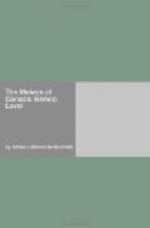At first, food, clothing and property were all paid for by exchange of goods. Men bartered, for example, a lot of ground for two cows and a pair of stockings; a more considerable piece of land was to be had for two oxen, a cow and a little money. “Poverty,” says Bossuet, speaking of other nations, “was not an evil; on the contrary, they looked upon it as a means of keeping their liberty more intact, there being nothing freer or more independent than a man who knows how to live on little, and who, without expecting anything from the protection or the largess of others, relies for his livelihood only on his industry and labour.” Voltaire has said with equal justice: “It is not the scarcity of money, but that of men and talent, which makes an empire weak.”
On the arrival of the royal troops coin became less rare. “Money is now common,” wrote Mother Incarnation, “these gentlemen having brought much of it. They pay cash for all they buy, both food and other necessaries.” Money was worth a fourth more than in France, thus fifteen cents were worth twenty. As a natural consequence, two currencies were established in New France, and the livre tournois (French franc) was distinguished from the franc of the country. The Indians were dealt with by exchanges, and one might see them traversing the streets of Quebec, Montreal or Three Rivers, offering from house to house rich furs, which they bartered for blankets, powder, lead, but above all, for that accursed firewater which caused such havoc among them, and such interminable disputes between the civil and the religious power. Intoxicating liquors were the source of many disorders, and we cannot too much regret that this stain rested upon the glory of New France. Yet such a society, situated in what was undeniably a difficult position, could not be expected to escape every imperfection.
The activity and the intelligence of Mgr. de Laval made themselves felt in every beneficent and progressive work. He could not remain indifferent to the education of his flock; we find him as zealous for the progress of primary education as for the development of his two seminaries or his school at St. Joachim. Primary instruction was given first by the good Recollets at Quebec, at Tadousac and at Three Rivers. The Jesuits replaced them, and were able, thanks to the munificence of the son of the Marquis de Gamache, to add a college to their elementary school at Quebec.




